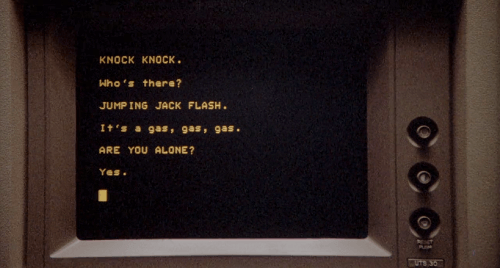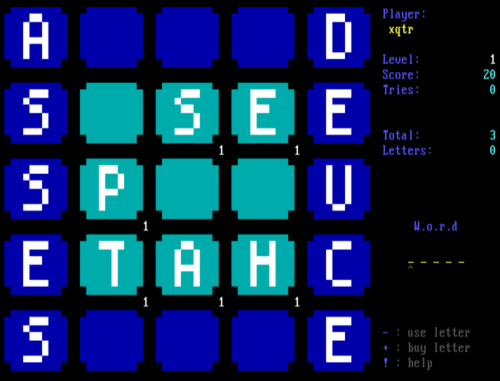It’s a new year and, reviewing my last year’s work of posts, it seems I failed pretty hard to live up to my own hopes and plans for what content I could produce in 2022. While I did at least start putting out some new releases (with reviving Demonic being a big component of that) I want to get back to more “bloggy” things and start off the year with another of these semi-autobiographical posts where I talk about the history of the scene from my own very self-centered perspective. Let’s dive into something I alluded to in my original About Me post – my handle. A lot of people have asked me about this over the years but I’ve rarely ever gone into it, and certainly not in any depth. So here we go, in more depth than anyone ever wanted.
When I finally got a modem and started calling BBSes, like all of us, I almost immediately discovered that I needed a handle. With nothing coming to mind, my brother suggested “Arioch”, taken from psychedelic English fantasy writer Michael Moorcock’s Elric books. That would do for the time being, and being named after a god of chaos is pretty damn cool, but I didn’t love it, especially having not actually read any of those books myself. Later, when I started calling more of the local underground systems, I briefly switched to using “Jello”; a bit cringe-worthy in how unimaginative it was, but it was at least a reference to something I was genuinely really into, my love of 80s punk band Dead Kennedys, whose Plastic Surgery Disasters and Give Me Convenience or Give Me Death were in danger of becoming permanent parts of my tape deck back then.

Finally, once I got even deeper into the esoteric world of the underground scene, I knew I needed a better handle. Something unique, something with a workable abbreviation, and I also wanted it to be something that actually sounded the part. When I first really started delving into the world of HPCAV, many of the text files and zines I could easily find were, unbeknownst to me, goddamn ancient. We’re talking stuff typed on Apple IIs by classic hackers who made up for the lack of 80 columns and lowercase characters by having fun, slightly subversive handles. The infamous Captain Crunch is always one of the first examples that comes to mind. “Jack Flash” had a similar feel while being a similarly obscure reference to hacker culture. This was made a million times more blatant once I replaced the F with a Ph in old school phone phreak tradition.
Okay, I can practically hear some of you screaming at your monitors wondering how in the hell the name “Jack Flash” is related to hacker culture. Well, I mentioned this in Getting into Amiga – Introduction as well as some of the retro gaming reviews I’ve done on my gaming blog, but as a kid I was literally obsessed with computers and spent years in limbo without one after my VIC-20 died. During that time, I would consume just about anything computer related that I could get my hands on. I’d jump on any computer I came across: at friend’s houses, in school computer labs and libraries, literally wherever I could, even spending likely suspicious amounts of time hanging around at the computer sections of department stores. I’d also buy and read magazines over and over and pine over computer sections in catalogs, and yeah, I’d watch any even vaguely related TV shows and movies, not that there were a ton. One of those movies was 1986’s “Jumpin’ Jack Flash”.
Jumpin’ Jack Flash is probably not a movie that a lot of people are familiar with these days. It stars Whoopi Goldberg (at near the beginning of her career) as Terry, a bank computer operator specializing in conducting wire transfers using some kind of an online banking system. As part of her process, she’d often casually message her peers on the other ends of those transfers, and one day ends up chatting with a mysterious hacker calling himself “Jumping Jack Flash” which, yes, is an anything but subtle reference to the Rolling Stones song. From there, the movie becomes a bit of a… well, it would probably be generous to call this a cold war spy movie. Instead it fits pretty cleanly into the 80s comedy detective suspense genre, movies like Beverly Hills Cop and Fletch, for example (complete with one of my favorite 80s action movie tropes, a goon spraying seemingly endless rounds out of a Micro Uzi without actually hitting much.) It’s not particularly bad by any means, and includes some early appearances by other familiar faces like Phil Hartman, Jon Lovitz, Jim Belusi, and Michael McKean (Saturday Night Live represent?!) and a cameo by Tracey Ullman.

On the technical side, you’ll see a lot of clearly labeled SPERRY UTS 30 terminals and the company is even name-dropped when a Sperry technician stops by at one point. For those unfamiliar, Sperry was a massive early player in the computer industry, known for their UNIVAC line of computers, and later merged with another big, early player, Burroughs Corporation, to form the probably better known (to people my age, at least) Unisys around the time this movie was released. Beyond that interesting endorsement, I’m not sure how much else here holds up. For instance, at one point Terry’s terminal changes from high resolution monochrome amber text to a low resolution, full color display in a pretty dramatic fashion. It’s a pretty cool effect, but from reading about the UTS 30 it seems like a movie gimmick, never mind the fact that the UTS 30 seems to have actually displayed in green, not amber. Terry’s monitor also has a bad habit of picking up Russian television which is… unlikely? I also question the whole system of just sitting on a terminal all day, chatting to random people to process wires, but who knows? Then there are scenes where, if you watch her hands, Whoopi is clearly just flapping her fingers around the home row keys rather than actually typing.
If you engage your suspension of disbelief even a little, none of these things are too egregious, and besides, by far the most interesting aspect of the movie is a relatively early depiction of two people striking up a relationship over a computer. The strange mix of intrigue you feel when reaching out across the ether to someone anonymous combined with forming a very real social connection feels genuine enough, and pretty palpable, which I’m sure is one of the reasons the movie stuck with me as a kid.
So there you have it! I’ve been using the handle “Jack Phlash” consistently ever since. And you guys thought I was some huge Rolling Stones fan… pfft! 😛

